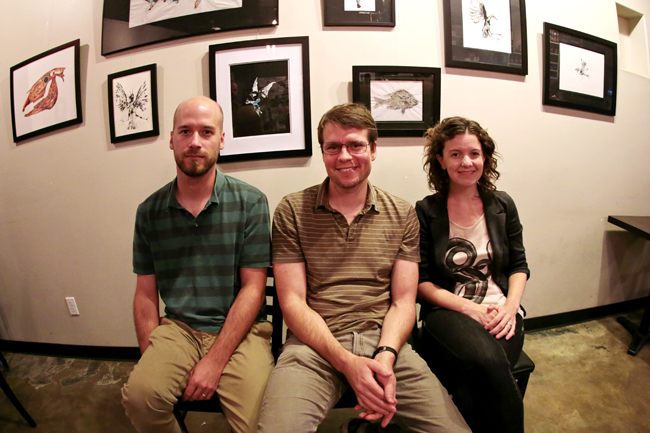Dead animals may decorate a rustic fireplace mantle, but it isn’t common to find them displayed as works of fine art. Japanese artists created Gyotaku, a traditional art form that dates back from the mid-1800s and involves putting ink on a dead fish, and then pressing it on rice paper to create an ink impression of the original specimen.
“Inked Animal” is a collection of art that was inspired by Gyotaku and has evolved into an exhibit that displays two disciplines, art and science, working together.
Adam Cohen, collections manager of Ichthyology at Texas Natural History Collections, works with partner Ben Labay, research associate and fisheries biologist at UT’s Texas Natural Science Center, to create lasting impressions of dead animals that would otherwise be lost to decay.
“On one level, the prints are simply realistic documentations of the specimens,” Cohen said. “We see these prints as crossing a blurry line into art in that they provoke people to appreciate the unique and sometimes haunting beauty of the specimens. Many of our prints are of partially dissected animals and capture unusual positions or body parts.”
Traditionally, Gyotaku was most commonly practiced with fish, but the prints in “Inked Animal” range from fish and birds to rodents and insects, and many other specimens.
The two scientists have found ways to print bones, feathers and fur, allowing an internal and external look at animals.
“Many pieces have blood, guts, feces or fur that are a visible part of the art,” Cohen said. “At first we sought to print intact animals in a very pristine way, as in the tradition of Gyotaku. Now we are starting to realize that some of the damaged specimens — mummified, rotten or dismembered — make the most interesting prints and tell more interesting stories. Our tolerance for ‘gross’ is very high.”
This tolerance for “gross” may be needed to extract the animals and create the art, but Cohen said viewers find the final prints to be “cute.” Still, the up-close view in such a vulnerable, and occasionally violent, state can surprise viewers.
“Sometimes people look very closely at a hair or blood stain and they realize that the animal was in fact right there touching paper,” Cohen said. “Many of the prints were created from animals that were disfigured, long dead and putrefied — not cute for sure.”
An animal’s death being published as art may seem cavalier to the animal itself, but the prints serve as an exhibition that allows the life of the animal to be appreciated and studied.
“I’d like for the public to look closely at our art and notice details in the animals that they might not have otherwise noticed,” Cohen said. “Some of these animals are shy or nocturnal and the prints can allow people to experience those animals that they might not have [an] opportunity to see alive.”
Both Cohen and Labay have extensive backgrounds in science, each having a bachelor’s degree in biology from UT, but they also have roots in art.
“I’ve been drawing and painting most of my life, but only as a hobby,” Labay said. “‘Inked Animal’ has been great in that it has allowed me to simultaneously explore my scientific and artistic interests. This is pretty common, I think. There are many scientists that are great artists, and I think many artists would make great scientists.”
Labay said most artists have a high capacity for detail and exploration with techniques, and being biologists, he and Cohen start from a place of curiosity and appreciation with regard to the animals.
“Both our art and science benefit from constantly exploring and testing,” Labay said. “I think they each, in their own way, help to keep me creating and thinking about different ways to go about things. Art is always being related to creativity of course, but I’d say there is a need for just as much creativity in science, and that great scientists show extreme creativity in their exploration and discovery.”















